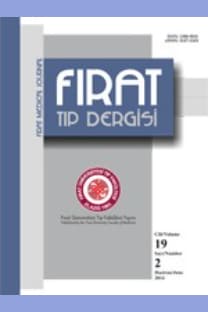Sfenoid Sinüs Anatomik Varyasyonlarının Çok Kesitli Bilgisayarlı Tomografi ile Değerlendirilmesi
Evaluation of Sphenoid Sinus Anatomic Variations Using Multislice Computed Tomography
___
- 1. Güldner C, Pistorius SM, Diogo I, Bien S, Sester-henn A, Werner JA. Analysis of pneumatization and neurovascular structures ofhe sphenoid sinus using cone-beam tomography (CBT). Acta Radiol 2012; 53: 214-9.
- 2. Leunig A, Betz CS, Sommer B, Sommer F. Ana-tomic variations of the sinuses; multiplanar CT-analysis in 641 patients. Laryngorhinootologie 2008; 87: 4829.
- 3. Sandulescu M, Rusu MC, Ciobanu IC, Ilie A, Jianu AM. More actors, different play: spheno-ethmoid cell intimately related to the maxillary nerve canal and cavernous sinus apex. Rom J Morphol Embryol 2011; 52: 931-5.
- 4. Hewaidi GH, Omami GM. Anatomic variation of sphenoid sinus & related structures in libyan popu-lation: CT scan study. Libyan J Med 2008; 3: 128-33.
- 5. Heskova G, Mellova Y, Holomanova A et al. As-sessment of the relation of the optic nerve to the posterior ethmoid and the sphenoid sinuses by computed tomography. Biomed Pap Med Fac Univ Palacky Olomouc Czech Repub 2009; 53: 149152.
- 6. Davoodi M, Saki N, Saki G, Rahim F. Anatomical variations of neurovascular structures adjacent sphenoid sinus using CT. Pakistan Journal of Bio-logical Sciences 2009; 12: 522-5.
- 7. Hamid O, Fiky LE, Hassan O, Kotb A, Fiky SE. Anatomic variations of the sphenoid sinus and their impact on transsphenoid pituitary surgery. Skull Base 2008; 18: 9-15.
- 8. Bademci G, Unal B. Surgical importance of neu-rovascular relationships of paranasal sinus region. Turk Neurosurg 2005; 15: 93-6.
- 9. Erdoğan S, Keskin G, Topdağ M, Sarı F, Öztürk M, İşeri M. Bilgisayarlı tomografide sfenoid sinüs anatomik varyasyonları. Sağlık Bilimleri Enstitüsü Dergisi 2015; 6: 55-8.
- 10. Evans JJ, Hwang YS, Lee JH. Pre-versus post-anterior clinoidectomymeasurements of the optic nerve, internal carotid artery, and opticocarotid tri-angle: a cadaveric morphometric study. Neurosur-gery 2000; 46: 1018-21.
- 11. Sirikci A, Bayazıt YA, Bayram M. Variations of sphenoid and related structures. Eur Radiol 2000; 10: 8448.
- 12. 12-Turkdogan FT, Turkdogan KA, Dogan M, Atalar MH. Assessment of sphenoid sinus related anatomic variations with computed tomography. Pan African Med J 2017; 27: 109.
- 13. Birsen U, Gulsah B, Yasemin K et al. Risky ana-tomic variations of sphenoid sinus for surgery. Surg Radil Anat 2006; 28: 195-201.
- 14. Tomovic S, Esmaeili A, Chan NJ et al. High-resolution computed tomography analysis of varia-tions of the sphenoid sinus. J Neurol Surg B Skull Base 2013; 74: 82-90.
- 15. D P, Prabhu LV, Kumar A, Pai MM, Kvn D. The anatomical variations in the neurovascular relations of the sphenoid sinus: an evaluation by coronal computed tomography. Turk Neurosurg 2015; 25: 289-93.
- 16. Dündar R, Kulduk E, Soy FK et al. Sfenoid sinüs-teki septum varyasyonlarının radyolojik incelen-mesi. Med Updates 2014; 4: 6-10.
- 17. Turna1 O, Aybar MD, Karagoz Y, Tuzcu G. Ana-tomic Variations of the Paranasal Sinus Region: Evaluation with Multidetector CT. İstanbul Med J 2014; 15: 104-9.
- 18. Nitinavakarn B, Thanaviratananich S, Sangsilp N. Anatomical variations of the lateral nasal wall and paranasal sinuses: A CT study for endoscopic si-nus surgery (ESS) in Thai patients. J Med Assoc Thai 2005; 88: 763-8.
- ISSN: 1300-9818
- Yayın Aralığı: 4
- Başlangıç: 2015
- Yayıncı: Fırat Üniversitesi Tıp Fakültesi
Sfenoid Sinüs Anatomik Varyasyonlarının Çok Kesitli Bilgisayarlı Tomografi ile Değerlendirilmesi
Hatice KAPLANOĞLU, Veysel KAPLANOĞLU
Esra ERTÜRK TEKİN, Uğurcan SAYILI, Atakan ATALAY, Ayhan UYSAL, Yüksel BAŞTÜRK, Mehmet Şah TOPÇUOĞLU
İntrakraniyal Lipomu Bulunan Pediatrik Hastaların Radyolojik Bulguları
6-18 Yaş Grubunda Poliklinik Başvurularında Tekrarlayan Karın Ağrısının Değerlendirilmesi
Şule DEMİR, Maşallah BARAN, Sezin AKMAN, Saadet ÇELİK CENGİZ
Diyabetik Ayak Hastalarında Anksiyete-Depresyon Bozukluğu ve Kemik Mineral Yoğunluğu
Faruk KILINÇ, Ahmet KARATAŞ, Ramazan Fazıl AKKOÇ, Gamze AYAZ, Kader UĞUR, Suna AYDIN, Tansel Ansal BALCI, Fikri Selçuk ŞİMŞEK, Umut AYDIN, Vehbi PEHLİVAN
Kovid-19 Pandemisinin Diş Hekimliği Araştırma Görevlilerinin Korunma Davranışlarına Etkisi
Osman ATAŞ, Kevser TUNCER KARA
Soğukla Uyarılan Ürtiker: Bir Olgu Sunumu
Mehmet KILIÇ, Erdal TAŞKIN, Leyla BULUT
Serum Albumin Düzeyleri ile Akut Pulmoner Emboli Klinik Formları Arasındaki İlişki
COVID-19’a Bağlı Kritik Süt Çocuğu Olgusu
Nihal KARAÇAYIR, Rahmi ÖZDEMİR, Damla GEÇKALAN SOYSAL, Gülten CİNGÖZ
Sakroiliak ve Kalça Ekleminin Subakut Brucella Osteoartriti: Bir Olgu Sunumu
